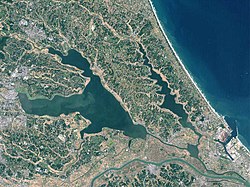Lake Kasumigaura
| Lake Kasumigaura 霞ヶ浦 |
|
|---|---|

The Landsat satellite picture of Lake Kasumigaura.
|
|
| Coordinates | 36°2′25″N 140°23′39″E / 36.04028°N 140.39417°ECoordinates: 36°2′25″N 140°23′39″E / 36.04028°N 140.39417°E |
| Type | warm Monomictic |
| Primary inflows | Sakura and Naka rivers and more than 30 small rivers |
| Primary outflows | Tone River |
| Catchment area | 1,915 km2 (739 sq mi) |
| Basin countries | Japan |
| Surface area | 220 km2 (85 sq mi) |
| Average depth | 4 m (13 ft) |
| Max. depth | 7 m (23 ft) |
| Water volume | 0.848 km3 (687,000 acre·ft) |
| Shore length1 | 252 km (157 mi) |
| Surface elevation | 0.16 m (6.3 in) |
| Islands | 0 |
| Settlements |
Tsuchiura, Ibaraki Kasumigaura, Ibaraki |
| 1 Shore length is not a well-defined measure. | |
Lake Kasumigaura (霞ヶ浦 Kasumigaura?) is the second-largest lake in Japan, located 60 km to the north-east of Tōkyō.
In a narrower sense and officially, Lake Kasumigaura refers to a waterbody with an area of 167.63 km2. In a wider sense, Lake Kasumigaura can also refer to a group of contiguous lakes, which includes Lake Kasumigaura proper, hereby referred to as Nishiura (西浦), and two smaller lakes, Kitaura (北浦; 35.16 km2) and Sotonasakaura (外浪逆浦; 5.85 km2), and also encompasses the rivers connecting them. In this case the total area is 220 km2.
About 45% of the land surrounding the lake is natural landscape and 43.5% is agricultural land.
Lake Kasumigaura originally was a brackish-water lagoon, with indirect connections to the Pacific Ocean via the Hitachigawa and Tone Rivers. In 1963, the construction of a gate near the confluence of these rivers disconnected the lake from its sources of ocean water. As a result, the salinity of Lake Kasumigaura declined, and today the lake contains fresh water. This lake was famous for its traditional fishery during the Edo period. But today, fishing production has drastically decreased due to water quality deterioration that was partially caused by the closure of the tide gate in 1963 for purposes of desalination.
Today, Lake Kasumigaura is used for fishing, irrigation, tourism, recreation, and for consumption by the surrounding public and local industry.
A variety of fish can be caught from the waters of Lake Kasumigaura, including smelt, Japanese icefish, crucian carp, goby, Japanese eel and river prawn. The most popular catch is cultivated carp, followed by smelt and goby. Another cultivated treasure from Lake Kasumigaura is the beautiful Kasumi freshwater pearls. They were known for their high luster and rosy hues, which is the result of a four-year cultivation period. However, in 2006, cultivation was discontinued as cheap freshwater pearls from China proved too difficult to compete against.
...
Wikipedia
